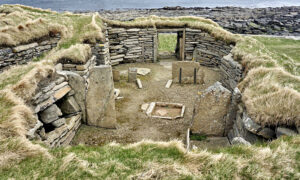The Oldest House in the World: A journey through ancient dwellings
When we think about the oldest house in the world, images of ancient ruins or primitive dwellings often come to mind. However, what exactly qualifies as the oldest house? There are several contenders around the globe, each with its own unique history and significance.
From prehistoric caves to the early structures of humanity, these ancient houses give us a glimpse into the way early humans lived, survived, and evolved.
The Oldest Known House: The Knap of Howar (Scotland)

The Knap of Howar, located on the island of Papa Westray in the Orkney Islands, Scotland, is widely considered the oldest preserved stone house in northern Europe. This Neolithic structure dates back approximately 5,500 years, built around 3700 BC. The house is remarkably well-preserved, providing insight into the lifestyle of early farming communities.
The house consists of two connected, rectangular buildings made from stone. The thick stone walls are a testament to the ingenuity of early human construction, capable of withstanding the harsh winds and cold temperatures of the Orkney Islands. It is believed that the inhabitants of Knap of Howar were farmers who cultivated crops and raised livestock, using the house as both living space and a storage area for food.
The Çatalhöyük Homes (Turkey)

Another contender for the title of the world’s oldest houses is the settlement of Çatalhöyük, located in central Turkey. This ancient city, which dates back around 9,000 years (from approximately 7100 BC to 5700 BC), consists of tightly packed mud-brick homes. The settlement is remarkable because the homes were built directly adjacent to one another, with no streets or roads between them. Instead, inhabitants would access their homes via ladders that led to roofs, with doorways located on the roofs themselves.
The Çatalhöyük houses were constructed using mud-brick and wood, and they were decorated with murals and carvings that provide valuable information about early human culture and belief systems. The people of Çatalhöyük were some of the first to practice agriculture, and the site is thought to represent an important transition in human history—from nomadic lifestyles to settled, agricultural communities.
The Chauvet Cave and the Cave Dwellings of Prehistoric Humans
While Knap of Howar and Çatalhöyük are some of the earliest known examples of permanent houses, early humans also sought shelter in caves long before building formal structures. The Chauvet Cave, located in southern France, is one of the most famous examples of prehistoric cave dwellings. The cave contains some of the earliest known cave paintings, which date back to around 32,000 years ago, created by the Upper Paleolithic people who lived there.
Although Chauvet Cave was primarily a site of artistic expression, it also provided shelter to early humans. Cave dwellings were used for protection from the elements and predators, and as the climate changed, people began to move toward constructing more permanent homes.
The Oldest House in the Americas: The Cliff Palace (USA)

In the Americas, the Cliff Palace, located in Mesa Verde National Park in Colorado, USA, is a notable example of an ancient house. Dating back to around the 12th century AD, the Cliff Palace is a series of cliff dwellings built by the Ancestral Puebloans. The homes were carved into the cliffside, offering protection from invaders and the harsh environment.
These dwellings were constructed with sandstone blocks and mortar, and they housed entire communities. The cliffside location also provided natural defenses, with narrow entryways and high cliffs making the homes difficult to access. The Cliff Palace remains a testament to the ingenuity and resilience of early North American cultures.
The Lascaux Cave and Early Shelter

Before humans began building permanent houses, early shelter was found in caves, many of which are famous for their stunning prehistoric art. The Lascaux Cave, located in southwestern France, is another example of a prehistoric site that offered shelter to early humans. Known for its vivid and well-preserved cave paintings, which date back to around 17,000 years ago, the cave was used as a place of shelter, as well as for artistic and ritual purposes.
The art found in caves like Lascaux provides a glimpse into the lives and beliefs of early human societies. While not necessarily “houses” in the modern sense, these caves were integral to the survival of early humans, offering both physical protection and a spiritual connection to the world around them.
In conclusion, the search for the oldest house in the world brings us to various remarkable sites, each representing a different phase in human development. From the stone-built houses of Knap of Howar to the cliff dwellings of the Cliff Palace, these structures are windows into the past. They reveal not only the ingenuity of early humans but also their adaptability, creativity, and ability to create lasting homes in challenging environments.
Though the Knap of Howar remains the oldest known stone-built house, the legacy of early human dwellings stretches back much further, with caves and primitive shelters serving as the first homes for our ancestors. As we continue to uncover these ancient sites, we gain a deeper understanding of our history and the evolution of human civilization.
Follow the Neptune Prime channel on WhatsApp:
Do you have breaking news, interview request, opinion, suggestion, or want your event covered? Email us at neptuneprime2233@gmail.com





